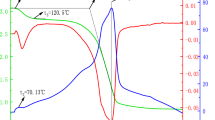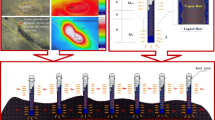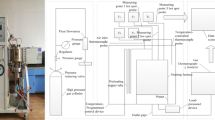Abstract
Suppressing spontaneous coal combustion with heat pipe (HP) is an effect fire fighting method in practice. To improve the heat transfer capacity of HPs in coal piles as much as possible, this work explores the optimal inclination angle of HPs to remove heat in the coal stockpiles. Based on the theory of fluid mechanics and heat transfer, a physical-mathematical model of coal-HP-air was established, and the spontaneous combustion process of coal piles and the effect of HPs at four inclination angles (θ) of 30°, 45°, 60°, and 90° on the spontaneous combustion of coal piles were studied. The results show that the presence of HPs can change the heat conduction path in a coal pile and help the coal pile to dissipate heat in time, and this process makes the temperature contours on both the windward side and the leeward side deform and exhibits a ‘saddle’-like cooling mode at the periphery of the HPs. As θ of the HPs increases, the area (ΔS) by which the spontaneous combustion danger zone (SCDZ) is decreased first increases and then decreases, and the maximum temperature (Tmax) drop values (ΔT) first increases and then decreases. Moreover, the thermal performance of the HPs at inclination angle of 60° is found to be higher than other tested inclination angles. When θ = 60°, the heat is largely removed, and the integrity of the SCDZ is destroyed, so that ΔS is 11.106 m2, ΔT is 13.1 °C, and the natural ignition period is extended by approximately 25 days. Consequently, this study provides a reference for the design and optimization of coal fire fighting engineering with HP application in the future.













Similar content being viewed by others
Abbreviations
- A :
-
Pre-factor [s–1]
- b n :
-
Fin height [m]
- c :
-
Heat capacity [J/(kg·K)]
- C :
-
Oxygen concentration [%]
- d :
-
Diameter [m]
- D :
-
Diffusion coefficient [m2/s]
- E :
-
Activation energy [mol/J]
- h :
-
Heat transfer coefficient [W/(m2·K)]
- k :
-
Permeability [m2]
- l :
-
Length [m]
- m :
-
Reaction constant
- Q :
-
Total heat flux of HP [W/m2]
- r :
-
Consumption rate of oxygen [kmol/(m–3·s–1)]
- R :
-
Heat resistance
- R ' :
-
Universal gas constant [J/mol·K]
- s n :
-
Fin space [m]
- t :
-
Time [s]
- T :
-
Temperature [K]
- u :
-
Velocity component in the x direction [m/s]
- U :
-
Wind velocity at the height z [m/s]
- U 10 :
-
Velocity at a height of 10 m, which is 3 [m/s]
- v :
-
Velocity component in the y direction [m/s]
- x :
-
x direction
- y :
-
y direction
- z :
-
Height [m]
- δ :
-
Fin thickness [m]
- ε :
-
Porosity of coal
- λ :
-
Thermal conductivity [W/m·K]
- ρ :
-
Density [kg/m3]
- a:
-
Air
- am:
-
Ambient
- c:
-
Condenser section
- e:
-
Evaporator section
- eff:
-
Equivalent
- i:
-
Inner
- l:
-
Liquid film
- o:
-
Outer
- s:
-
Coal
References
Kim CJ, Sohn CH (2012) A novel method to suppress spontaneous ignition of coal stockpiles in a coal storage yard. Fuel Process Technol 100:73–83
Wu YG, Yu XY, Hu SY, Shao H, Liao Q, Fan YR (2019) Experimental study of the effects of stacking modes on the spontaneous combustion of coal gangue. Process Saf Environ Prot 123:39–47
Song ZY, Kuenzer C, Zhu HQ, Zhang Z, Jia YR, Sun YL, Zhang JZ (2015) Analysis of coal fire dynamics in the Wuda syncline impacted by fire–fighting activities based on in-situ observations and Landsat–8 remote sensing data. Int J Coal Geol 142:91–102
Li TP, Teng Z, Ma X (2017) Thousands of tons of coal self-ignited in a coal field in Tacheng region, Xinjiang Uygur Autonomous Region. http://www.sohu.com/a/164718814_99971212
Chatterjee RS (2006) Coal fire mapping from satellite thermal IR data—a case example in Jharia coalfield, Jharkhand, India. ISPRS J Photogramm Remote Sens 60:113–128
Ellyett CD, Fleming AW (1974) Thermal infrared imagery of the burning mountain coal fire. Remote Sens Environ 3:79–86
Finkelman RB (2004) Potential health impacts of burning coal beds and waste banks. Int J Coal Geol 59(1):19–24
Wang J, Zhang J, Zhu K, Zhou L (2016) Anatomy of explosives spontaneous combustion accidents in the Chinese underground coal mine: causes and prevention. Process Saf Prog 35:221–227
Zhao PX, Liu H, Li SG, Lin HF, Jia YY, Yan M (2019) Experimental investigation of the adsorption characteristics of mixed coal and variations of specific surface areas before and after CH4 adsorption. Appl Sci-Basel 9(3):524–541
Sipilä J, Auerkari P, Heikkilä AM, Tuominen R, Vela I, Itkonen J, Rinne M, Aaltonen K (2012) Risk and mitigation of self-heating and spontaneous combustion in underground coal storage. J Loss Prev Process Ind 25(3):617–622
Ma L, Wang WF, Deng J, Zhang XH, Wang ZP (2014) Effect of CO2 on characteristics of oxidation combustion for coal. J China Coal Soc 39(S2):397–404
Kim CJ, Sohn CH (2016) Effects of wind barrier design and closed coal storage on spontaneous ignition of coal stockpiles. J Loss Prev Process Ind 40:529–536
Fierro V, Miranda JL, Romero C, Andrés JM, Arriaga A, Schmal D, Visser GH (1999) Prevention of spontaneous combustion in coal stockpiles: experimental results in coal storage yard. Fuel Process Technol 59(1):23–34
Zhu HQ, Song ZY, Tan B, Hao YZ (2013) Numerical investigation and theoretical prediction of self-ignition characteristics of coarse coal stockpiles. J Loss Prev Process Ind 26(1):236–244
Wessling S (2007) The investigation of underground coal fires–towards a numerical approach for thermally, hydraulically, and chemically coupled processes. Westfälische Wilhelms-Univ Muenster, Master Thesis. (in Germany)
Schmidt M, Suhendra S, Ruter H (2010) Heat pipes-suitable for extinguishing underground coal fire? Proceedings of second international conference on Coal Fire Research, Berlin, Germany 433–437
Senthilkumar R, Vaidyanathan S, Sivaraman B (2012) Comparative study on heat pipe performance using aqueous solutions of alcohols. Heat Mass Transf 48:2033–2040
Narcy M, Lips S, Sartre V (2018) Experimental investigation of a confined flat two-phase thermosyphon for electronics cooling. Exp Thermal Fluid Sci 96:516–529
Srimuang W, Amatachaya P (2012) A review of the applications of heat pipe heat exchangers for heat recovery. Renew Sust Energ Rev 16(6):4303–4315
Liang L, Quan YM, Ke ZY (2011) Investigation of tool-chip interface temperature in dry turning assisted by heat pipe cooling. Int J Adv Manuf Technol 54(1):35–43
Zhang MY, Lai YM, Zhang JM, Sun ZZ (2011) Numerical study on cooling characteristics of two-phase closed thermosyphon embankment in permafrost regions. Cold Reg Sci Technol 65:203–210
Li B, Deng J, Xiao Y, Zhai XW, Shu CM, Gao W (2018) Heat transfer capacity of heat pipes: an application in coalfield wildfire in China. Heat Mass Transf 54(6):1755–1766
Deng J, Li B, Ma L (2015) Influence of heat pipes on temperature distribution in coal storage pile. China Safety Sci J 25(06):62–67
Cheng FM, Chang ZC, Li B, Deng J, Yi X, Ma L (2019) Numerical simulation on thermal migration behavior of spontaneous combustion coal pile based on heat pipe cooling technology. J Xi'an Univ Sci Technol 39(04):581–588
Zhang YP, Wang JG, Ji CF, Ma L (2017) Cooling effect analysis of heat pipe suppressing coal spontaneous. Coal Eng 49(02):100–102
Noie SH (2007) Effect of inclination angle and filling ratio on thermal performance of a two-phase closed thermosyphon under normal operating conditions. Heat Transf Eng 28:365–371
Liu ZH, Li YY, Bao R (2010) Thermal performance of inclined grooved heat pipes using nanofluids. Int J Therm Sci 49:1680–1687
Teng TP, Hsu HG, Mo HE, Chen CC (2010) Thermal efficiency of heat pipe with alumina nanofluid. J Alloys Compd 504S:S380–S384
Wang PY, Chen XJ, Liu ZH, Liu YP (2012) Application of nanofluid in an inclined mesh wicked heat pipes. Thermochim Acta 539:100–108
Hung YH, Teng TP, Lin BG (2013) Evaluation of the thermal performance of a heat pipe using alumina nanofluids. Exp Thermal Fluid Sci 44:504–511
Senthilkumar R, Vaidyanathan S, Sivaraman B (2012) Effect of inclination angle in heat pipe performance using copper nanofluid. Procedia Eng 38:3715–3721
Ghanbarpour M, Nikkam N, Khodabandeh R, Toprak MS (2015) Thermal performance of inclined screen mesh heat pipes using silver nanofluids. Int Commun Heat Mass Transf 67:14–20
Zhang MY, Lai YM, Pei WS, Jin L (2014) Effect of inclination angle on the heat transfer performance of a two-phase closed thermosyphon under low temperature conditions. J Cold Reg Eng 28(4):04014007
Zhang MY, Lai YM, Wu QB, Yu QH, Zhao T, Pei WS, Zhang JM (2016) A full-scale field experiment to evaluate the cooling performance of a novel composite embankment in permafrost regions. Inter J Heat Mass Transf 95:1047–1056
Pei WS, Zhang MY, Yan ZR, Li SY, Lai YM (2019) Numerical evaluation of the cooling performance of a composite L-shaped two-phase closed thermosyphon (LTPCT) technique in permafrost regions. Sol Energy 177:22–31
Zhang J, Ren T, Liang YT, Wang ZW (2016) A review on numerical solutions to self-heating of coal stockpile: mechanism, theoretical basis, and variable study. Fuel 182:80–109
Li SG, Xu JC (1999) Experimental study of spontaneous combustion rule of ground coal storage pile. J China Univ Min Technol 1:42–46
Zhou YY (2008) Study on the heat transfer performance of the gravitational heat pipe used underground, Master Thesis, China Univ Petrol, Dongying, Shandong, China 55–72. (in Chinese)
Nield DA, Bejan A (2006) Convection in porous media. Springer, New York, 640 pp
Yang YL, Li ZH, Tang YB, Liu Z, Ji HJ (2014) Fine coal covering for preventing spontaneous combustion of coal pile. Nat Hazards 74(2):603–622
Akgun F, Essenhigh RH (2001) Self-ignition characteristics of coal stockpiles: theoretical prediction from a two-dimensional unsteady-state model. Fuel 80(3):409–415
Smith AC, Lazzara CP (1987) Spontaneous combustion studies of U.S. coals. U.S. Dept. of the Interior, Bureau of Mines, Pittsburgh 28 pp
Fierro V, Miranda JL, Romero C, Andrés JM, Arriag A, Schmalc D (2001) Model predictions and experimental results on self-heating prevention of stockpiled coals. Fuel 80(1):125–134
Deng J, Xiao Y, Li QW, Lu J, Wen H (2015) Experimental studies of spontaneous combustion and anaerobic cooling of coal. Fuel 157:261–269
Acknowledgments
The authors are thankful for the financial support from the National Natural Science Foundation of China (nos. 51904054 and 51774232), the Fundamental Research Funds for the Central Universities (no. DUT19RC(4)002).
Author information
Authors and Affiliations
Corresponding authors
Additional information
Publisher’s note
Springer Nature remains neutral with regard to jurisdictional claims in published maps and institutional affiliations.
Rights and permissions
About this article
Cite this article
Cheng, F., Chang, Z., Deng, J. et al. Numerical evaluation of inclined heat pipes on suppressing spontaneous coal combustion. Heat Mass Transfer 56, 1861–1874 (2020). https://doi.org/10.1007/s00231-020-02819-8
Received:
Accepted:
Published:
Issue Date:
DOI: https://doi.org/10.1007/s00231-020-02819-8




